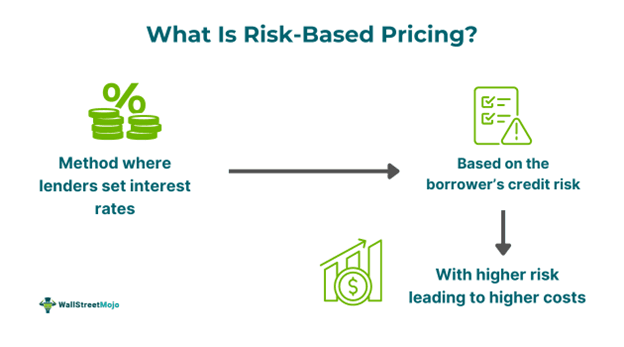When you apply for a loan or mortgage in the United States, you might wonder why your neighbor got a lower interest rate—even though you applied for a similar loan. The answer often lies in a method called Risk-Based Pricing.
Risk-based pricing is a critical component of modern mortgage lending, allowing lenders to offer interest rates and terms tailored to each borrower’s financial risk profile.
In this blog, we’ll explain what risk-based pricing is, why it matters, and how it works in the U.S. mortgage and lending landscape.
Risk-based pricing is the process of adjusting loan terms—especially interest rates—based on the borrower’s perceived credit risk. The higher the risk, the more a borrower is likely to pay in interest or fees.
This strategy allows lenders to protect themselves against potential losses while still offering loans to a broader range of borrowers, including those with less-than-perfect credit.
Lenders are in the business of managing risk. Each loan comes with a chance that the borrower may not repay it. Risk-based pricing helps:
- Offset potential losses from defaults
- Expand lending to more borrowers, including subprime clients
- Keep lending profitable and sustainable
- Stay competitive in the market while managing internal risk metrics
Lenders in the U.S. use several borrower-related factors to determine the risk level—and therefore the rate:
This is the most common metric. Borrowers with a higher credit score get lower interest rates, while those with lower scores pay more.
| Credit Score | Typical Risk Level | Interest Rate Impact |
|---|---|---|
| 760+ | Very Low Risk | Lowest rates |
| 700–759 | Low Risk | Competitive rates |
| 640–699 | Medium Risk | Higher rates |
| 580–639 | High Risk | Much higher rates |
| < 580 | Very High Risk | May be declined or priced very high |
Higher LTVs (e.g., 95% loan, 5% down payment) are seen as riskier. Borrowers with lower down payments often face higher pricing or must buy Private Mortgage Insurance (PMI).
A higher DTI suggests limited repayment capacity, increasing risk. Lenders price loans higher for borrowers who are already heavily in debt.
Different loan products carry different levels of risk. For example:
- Adjustable-Rate Mortgages (ARMs) may have lower initial rates but can rise.
- Jumbo loans (loans exceeding conforming limits) often come with premium pricing due to the larger exposure.
Imagine two borrowers applying for a 30-year fixed-rate mortgage:
| Factor | Borrower A | Borrower B |
|---|---|---|
| Credit Score | 780 | 620 |
| Down Payment | 20% | 5% |
| DTI Ratio | 30% | 48% |
| Interest Rate | 6.25% | 8.75% |
| Monthly Payment | $1,231 | $1,574 |
👉 The same loan amount could cost hundreds more per month based on credit risk.
U.S. law requires that risk-based pricing is done transparently and without discrimination.
- Fair Credit Reporting Act (FCRA): Requires lenders to inform borrowers if they received less favorable terms due to credit history.
- Equal Credit Opportunity Act (ECOA): Prevents pricing based on race, gender, religion, or other protected classes.
- Risk-Based Pricing Notices: Must be issued to borrowers receiving higher pricing based on credit information.
Understanding risk-based pricing can help borrowers:
- Improve their credit score before applying
- Save thousands in interest over the life of the loan
- Shop around for the best offer, especially if their risk profile is borderline
With advancements in AI, big data, and real-time credit scoring, risk-based pricing is becoming more accurate and personalized. Expect more dynamic pricing models in the future, especially for fintech and digital lenders.
Risk-based pricing is a smart, data-driven approach that allows lenders to match loan terms to borrower profiles—rewarding lower-risk customers and protecting against defaults.
For borrowers, it’s a reminder that credit behavior matters—and that better financial habits can directly lead to better loan offers.

